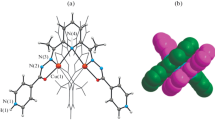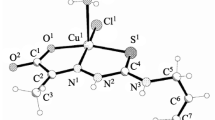Abstract
New picoline adducts with carbamic acid [(furan-2-yl)methylene]hydrazide–CuII (CFMH) (1); thiocarbamic acid [(furan-2-yl)methylene]hydrazide–CuII (TFMH) (2); carbamic acid [(furan-2-yl)ethylidene]hydrazide–CuII (CFEH) (3), thiocarbamic acid [(furan-2-yl)ethylidene]hydrazide–CuII (TFEH) (4); carbamic acid [(thiophene-2-yl) methylene]hydrazide–CuII (CTMH) (5), thiocarbamic acid [(thiophene-2-yl)methylene]hydrazide–CuII (TTMH) (6), carbamic acid [(thiophene-2-yl)ethylidene]hydrazide–CuII (CTEH) (7), thiocarbamic acid [(thiophene-2-yl)ethylidene]hydrazide–CuII (TTEH) (8) have been prepared and characterized by analytical, i.r., electronic, e.s.r. and c.v. spectral data. The electronic spectra suggest distorted octahedral geometry for all the picoline adducts. E.s.r. g ∥ values lie between 2.251–2.286 at l.n.t. All the adducts undergo a quasi-reversible one-electron reduction in the range +0.47 to +0.51 V versus s.c.e., attributable to the CuIII/CuII redox couple. The electron transfer is much faster in the semicarbazone complexes than in the thiosemicarbazone complexes. All adducts showed increased nuclease activity in the presence of oxidant; the nuclease activity is compared with that of the parent copper(II) complexes.
Similar content being viewed by others
References
L. Helleman and C.C. Stock, J. Biol. Chem., 125, 771 (1983).
N. Hashino, Y. Fukuda and K. Sone, Transition Met. Chem., 4, 183 (1979).
G. Wilkinson, Comprehensive Coordination Chemistry, Pergamon Press, Oxford 1987, Vol 5 pp 687 and 725; Vol 6, p 494.
J. Costamagna, J. Vargas, R. Latorse, A. Alvarado and G. Mena, Coord. Chem. Rev., 119, 67 (1992).
S.E. Livingstone, Cancer Forum, 15, 144 (1978).
D.R. Williams, Chem. Rev., 72, 203 (1972).
R.B. Martin and Y.H. Marian, in H. Sigel (Ed.), Metal ions in Biological Systems, Marcel Dekker Inc., New York, 1987 Vol 21, pp 57-124.
R.R. Joshi and K.N. Ganesh, Biochem. Biophys. Res. Commun., 182, 588 (1992).
M.J. Levy, Biochemistry, 27, 2647 (1988).
S.H. Chiou, J. Biochem., 94, 1259 (1983).
K. Veda, J. Morita and J. Komano, J. Antibiotics, 34, 317 (1981).
C.J. Reed and K.T. Douglas, Biochem. J., 275, 601 (1991).
M. Chikira, Takahirosato, W.E. Antholine and D.H. Petering, J. Biol. Chem., 266, 2859 (1991).
S. Hashimoto and Y. Nakamura, J. Chem. Soc. Chem. Commun., 1413 (1995).
D.S. Sigman, A. Majumder and D.M. Perrin, Chem. Rev., 93, 2295 (1993).
S.E. Livingstone, Coord. Chem. Rev., 7, 59 (1971).
M.J.M. Compbell, Coord. Chem. Rev., 15, 279 (1975).
M. Akbar Ali and S.E. Livingstone, Coord. Chem. Rev., 13, 101 (1974).
D.X. West and A.E. Liberta, Coord. Chem. Rev., 123, 49 (1993).
K. Hussain Reddy, P. Sambasiva Reddy and P. Ravindra Babu, Transition Met. Chem., 25, 505 (2000).
T. Maniatis, E.F. Fritsch and J. Sambrook, Molecular cloning, A Laboratory Manual, Cold Spring Harbor Lab Press Plain View, NY 1982, pp 149-172.
C.R.K. Rao and P.S. Zacharias, Polyhedron, 16, 1201 (1997).
S. Mandal, R. Shukla and P.K. Bharadwaj, Polyhedron, 11, 1885 (1992).
M.A. Hitchman and T.D. Waite, Inorg. Chem., 15, 2150 (1976).
K.W. Penfield, A.A. Gewirth and E.J. Solomon, J. Am. Chem. Soc., 107, 4519 (1985).
K. Nakamoto, Infrared and Raman spectra of Inorganic and Coordination Compounds, Wiley Interscience, New York, 1978.
D. Kivelson and R. Neiman, J. Chem. Phy., 35, 149 (1961).
B. Singh, B.P. Yadava and R.C. Aggarwal, Indian J. Chem., 23A, 441 (1984).
G. Giordano and R.D. Bereman, J. Am. Chem. Soc., 96, 1019 (1974).
A. Abragam and M.H.L. Pryce, Proc. Roy. Soc. (London), 206, 164 (1961).
V. Sakaguchi and A.W. Addison, J. Chem. Soc., Dalton Trans., 600 (1979).
R. Shukla, S. Mandal and P.K. Bharadwaj, Polyhedron, 12, 83 (1993).
X.H. Bu, Z.H. Zhang, X. Cao, S. Ma and Y. Tiohen, Polyhedron, 16, 3525 (1997).
A. Pasini, E. Bermini and M. Scaglia, Polyhedron, 15, 4461 (1996).
S. Djebbar-Sid, O. Benali-Baitich and J.P. Deloume, Polyhedron, 16, 2175 (1997).
C.C. Cheng, S.E. Rokita and C.J. Burrows, Angew Chem. Int. Edit. Engl. 32, 277 (1993).
X.H. Bu, Z.H. Zhang, X. Cao, S. Ma and Y. Tichen, Polyhedron, 16, 3525 (1997).
K. Hussain Reddy, M. Radhakrishna Reddy and K. Mohan Raju, Ind. J. Chem., 38A, 299-302 (1999).
P. Marfey and E. Robinson, Mutat. Res., 86, 155 (1981).
K. Yamamoto and S.C. Kawanishi, J. Biol. Chem., 264, 15435 (1989).
Author information
Authors and Affiliations
Rights and permissions
About this article
Cite this article
Reddy, K.H., Reddy, P.S. & Babu, P.R. Nuclease activity of mixed ligand complexes of copper(II) with heteroaromatic derivatives and picoline. Transition Metal Chemistry 25, 505–510 (2000). https://doi.org/10.1023/A:1007038514536
Issue Date:
DOI: https://doi.org/10.1023/A:1007038514536




